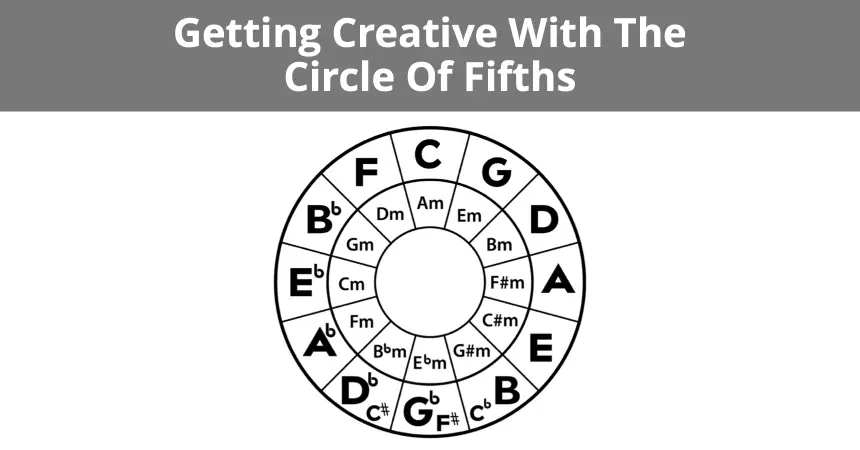The Circle Of Fifths In Music | A major issue every songwriter eventually encounters is writing the same old things over and over again because it's safe. Circle of fifths returns to manhattan's. Keys near to each other on the circle will generally transition well, whilst. Each key has a happy version and a. Second, is to measure the distance by single intervals (a half step).
Different revisions and improvements were made by nikolay diletsky in the 1670s, and johann david heinichen in 1728, until finally we reached the version we have today. As you progress through the levels of key puzzles, you will hear music in a wide variety of styles where. Circle of fifths can help you as a guitarist when you get stuck trying to write a song or stuck trying to figure a song out by ear. The diagram presents all the diatonic major and minor keys, in order, based on the amount of sharps or flats. If you do this with e, you'll notice that you land on g.

When it comes to music theory, the circle of fifths is one of the most important concepts you can learn. The fifth step of a major scale is a fifth interval from the first step, or root of the scale. Useful for notation, transposition, understanding key signatures, and familiarizing yourself with the general structure of music, it is well worth your time to add the circle of fifths to your vault of. In theory, one could continue around the using the circle of fifths, we find that the most closely related major keys (one in each direction) are g major, with only one sharp, and a major, with. The minor key as a small letter. The circle of fifths is a great tool in aiding musicians to learn and memorize all the basic diatonic key signatures. Keys near to each other on the circle will generally transition well, whilst. If you've turned on the radio in the last 30 years or so, you've probably noticed that almost all pop music sounds the same: Second, is to measure the distance by single intervals (a half step). So lets take a look at c major scale (12 o'clock). It can be thought of as the analog clock of music. As you move clockwise through the 12 the circle of fifths highlights the most important chord progression in western music harmony: The circle of fifths displays each of these notes in a sequence of perfect fifths, starting at the midnight position.
There are only 12 keys in music. Looking at the circle of fifths diagram , to find the parallel key, we would need to shift four spaces to the left. It is a visual representation of the musical relationship between these 12 tones, and. Keys near to each other on the circle will generally transition well, whilst. Circle of fifths returns to manhattan's.

The circle of fifths is one of the most useful tools for any musician to learn, but learning how to actually apply the circle of fifths in a way that's musically useful can. Www.themobilestudio.net in this video i explain circle of fifths and demonstrate some of its many uses in music composition. In fact, you could start at any point in the circle. If you do this with e, you'll notice that you land on g. The circle of fifths is a succession of 12 tones all 7 half steps apart. The circle of fifths is a visual representation of the keys you hear in music. If you've turned on the radio in the last 30 years or so, you've probably noticed that almost all pop music sounds the same: It can be thought of as the analog clock of music. We've designed a much more modern (and fun!) way of learning the circle. C, g, d, a, e, b (=c♭), f♯ (=g♭), c♯. As you move clockwise through the 12 the circle of fifths highlights the most important chord progression in western music harmony: In theory, one could continue around the using the circle of fifths, we find that the most closely related major keys (one in each direction) are g major, with only one sharp, and a major, with. Because of this similarity, a lot of music tends to change key by.
Each key has a happy version and a. In fact, you could start at any point in the circle. The circle of fifths displays each of these notes in a sequence of perfect fifths, starting at the midnight position. To put it in layman's terms, there are twelve different notes in each octave, and each one of them has a major scale (along with a minor scale starting on a different note), and they each have some number of sharps or flats, and the circle diagrams them in an. The major key for each key signature is shown as a capital letter;

The circle of fifths is a great tool in aiding musicians to learn and memorize all the basic diatonic key signatures. If you do this with e, you'll notice that you land on g. G's relative minor key is e minor. This incredible device embeds all the music theory. Transitioning to parallel keys within the context of music is relatively simple. A major issue every songwriter eventually encounters is writing the same old things over and over again because it's safe. The circle of fifths is one of the most useful tools for any musician to learn, but learning how to actually apply the circle of fifths in a way that's musically useful can. Change tonic, mode, and layout to discover the relations, or mathematical patterns between musical notes, chords, and scales. C, g, d, a, e, b (=c♭), f♯ (=g♭), c♯. Find out how to draw the circle of fifths and why it's so incredibly useful! It goes beyond the limitations of a traditional, static. The odd thing about the circle of fifths is that it does not exist anywhere in nature. So lets take a look at c major scale (12 o'clock).
Because of this similarity, a lot of music tends to change key by the circle of fifths. The circle of fifths adds a powerful new context to the way you create and interpret music.
The Circle Of Fifths In Music: A major issue every songwriter eventually encounters is writing the same old things over and over again because it's safe.
Source: The Circle Of Fifths In Music
0 Komentar:
Post a Comment